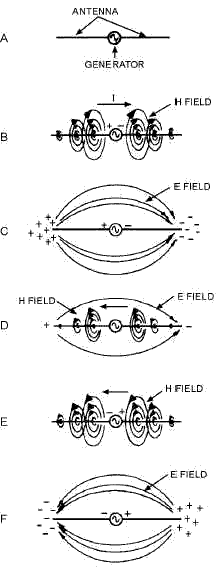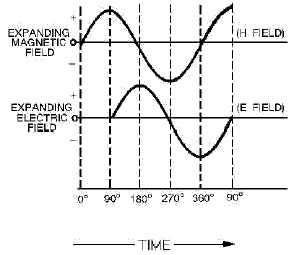Radio Waves
RADIO WAVES and PROPAGATION IN ELECTROMAGNETIC FIELDS
The way energy is propagated into free space is a source of great dispute among people concerned with it. Although many theories have been proposed, the following theory adequately explains the phenomena and has been widely accepted.
There are two basic fields associated with every antenna; an INDUCTION FIELD and a RADIATION FIELD. The field associated with the energy stored in the antenna is the induction field. This field is said to provide no part in the transmission of electro-magnetic energy through free space. However, without the presence of the induction field, there would be no energy radiated.
THE INDUCTION FIELD IN RADIO WAVES
In the figure below, a low-frequency generator connected to an antenna, will help you understand how the induction field is produced. Let's follow the generator through one cycle of operation.

Induction field OF radio waves about an antenna.
Initially, you can consider that the generator output is zero and that no fields exist about the antenna, as shown in view A. Now assume that the generator produces a slight potential and has the instantaneous polarity shown in view B. Because of this slight potential, the antenna capacitance acts as a short, allowing a large flow of current (I) through the antenna in the direction shown. This current flow, in turn, produces a large magnetic field about the antenna.
Since the flow of current at each end of the antenna is minimum, the corresponding magnetic fields at each end of the antenna are also minimum. As time passes, charges, which oppose antenna current and produce an electrostatic field (E field), collect at each end of the antenna. Eventually, the antenna capacitance becomes fully charged and stops current flow through the antenna. Under this condition, the electrostatic field is maximum, and the magnetic field (H field) is fully collapsed, as shown in view C.
As the generator potential decreases back to zero, the potential of the antenna begins to discharge. During the discharging process, the electrostatic field collapses and the direction of current flow reverses, as shown in view D. When the current again begins to flow, an associated magnetic field is generated. Eventually, the electrostatic field completely collapses, the generator potential reverses, and current is maximum, as shown in view E.
As charges collect at each end of the antenna, an electrostatic field is produced and current flow decreases. This causes the magnetic field to begin collapsing. The collapsing magnetic field produces more current flow, a greater accumulation of charge, and a greater electrostatic field. The antenna gradually reaches the condition shown in view F, where current is zero and the collected charges are maximum.
As the generator potential again decreases toward zero, the antenna begins to discharge and the electrostatic field begins to collapse. When the generator potential reaches zero, discharge current is maximum and the associated magnetic field is maximum. A brief time later, generator potential reverses, and the condition shown in view B recurs.
NOTE: The electric field (E field) and the electrostatic field (E field) are the same. They will be used interchangeably throughout this text.
The graph shown in the figure below shows the relationship between the magnetic (H) field and the electric (E) field plotted against time. Note that the two fields are 90 degrees out of phase with each other. If you compare the graph in the figure below with the figure above, you will notice that the two fields around the antenna are displaced 90 degrees from each other in space. (The H field exists in a plane perpendicular to the antenna. The E field exists in a plane parallel with the antenna, as shown in the figure above.)

Phase relationship of induction field components for radio waves.
All the energy supplied to the induction field is returned to the
antenna by the collapsing E and H fields. No energy or radio waves from the induction
field are radiated from the antenna. Therefore, the induction field is
considered a local field and plays no part in the transmission of
electromagnetic energy. The induction field represents only the stored
energy in the antenna and is responsible only for the resonant effects
that the antenna reflects to the generator.
Radiation-fields and radiation from an antenna
Radio waves and components
Wavelength to frequency conversions
Wave polarization
Atmospheric-propagation: reflection, refraction, and diffraction
The effect of the Earth's atmosphere on waves
Wave transmission
Inosophere-structure: ionization, recombination, refraction, and the four distinct layers of the ionosphere
Density-of-layer, the angle of incidence, and the effects of frequency on the critical angle
Skip-distance/skip-zone, propagation paths, and absorption in the ionosphere
Multipath and selective fading
Transmission-losses and types of interference
Ionosphere-variations: regular and irregular, sun-spot, and seasonal variations
Sporadic-E: sudden ionospheric disturbances and ionospheric storms.
Frequency selection considerations
Weather versus propagation
Tropospheric propagation and scattering















